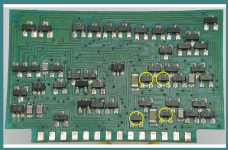Got an untested Rockford 200DSM with leaking caps on the preamp riser board. Checked the amp for the usual blown mosfets (none), then thoroughly cleaned & recapped the entire amp 100% except for the large power supply caps. Still wasn't getting audio through the preamp board so I replaced the LM833 chips and now have clean audio. I made the rookie mistake of running the amp outside the heatsink for a few minutes on music and ended up blowing a couple outputs on the right channel. Replaced all 6 IRF540 and that channel works fine. I thought the left channel was good, but looking at the outputs with a 50hz tone I'm seeing the following from the two channels, and I'm not sure where to look:
Right channel:

Left channel (at different input voltages):



Right channel:
Left channel (at different input voltages):
Do you have the tutorial?
Check the 33 ohm resistors on the driver board.
Which driver boards do you have (all resistors on one side or mixed)?
Check the 33 ohm resistors on the driver board.
Which driver boards do you have (all resistors on one side or mixed)?
I don't have the tutorial. The boards have all the resistors on one side.
Two 33ohm resistors per board all test okay.
Two 33ohm resistors per board all test okay.
Looks like I have a bad solder joint in the riser board. I can make the waveform distort or correct by flexing the board.
I need to pull the whole board back out of the sink and probably reflow the left riser board joints. I'll check again after that, but that seems to be the issue.
An aside question...is it harmful to this style amp to probe both channels at the same with a scope when both probes share a common ground?
You can't connect the scope ground to the right negative speaker terminal since it's the active speaker terminal. If you have your scope grounded to the 12v power supply ground terminal, you don't need to use a ground connection at the terminals. You can freely probe any speaker terminal with the tip of the probes. Probing both is no different than probing one.
Thanks for the scope tips, that makes sense.
I reflowed the solder on all the riser board connections at the main board. That must have added or removed enough stress on the board to correct the waveform on the left channel "at rest", but I can still recreate it if I push/pull gently on the top edge of the board to flex the board slightly. On the right channel if I do the same I get a small change in amplitude, but no added distortion.
I found that with an 8ohm load, but same output voltage, I can't even get it to distort by flexing the board, but at 4 ohms I can get it to distort with some effort, and with a 2 ohm load I can get it to distort with very little effort. I tried pushing on individual components with a non-conductive "stick" but couldn't narrow it down. I also wonder about all the tiny vias on the board.
I reflowed the solder on all the riser board connections at the main board. That must have added or removed enough stress on the board to correct the waveform on the left channel "at rest", but I can still recreate it if I push/pull gently on the top edge of the board to flex the board slightly. On the right channel if I do the same I get a small change in amplitude, but no added distortion.
I found that with an 8ohm load, but same output voltage, I can't even get it to distort by flexing the board, but at 4 ohms I can get it to distort with some effort, and with a 2 ohm load I can get it to distort with very little effort. I tried pushing on individual components with a non-conductive "stick" but couldn't narrow it down. I also wonder about all the tiny vias on the board.
The forum member seankane had some replacement driver boards at one time. You might want to message him to see if he still has the replacements.
Since the problem could be elsewhere, you could swap the boards (left/right) to see if the problem follows the board.
Since the problem could be elsewhere, you could swap the boards (left/right) to see if the problem follows the board.
I did talk to Sean, and he has the boards still. I was able to find the problem on both boards. There was a 100ohm resistor with a failing solder joint on the left channel causing the breakup, and a 3320ohm resistor with a failing solder joint causing the change in amplitude on the right channel. Interestingly those two resistors are basically in the same mirrored position on the amp, at the bottom of the boards closest to the output side of the amp. After reflowing the solder on those I can aggressively flex the boards without any change on the scope
For anyone who might end up looking for answers, here are some pictures of part of what this amp needed for repair.
Replace leaky caps & clean, new gain pots, replace broken RCA block, reflow remote tab & various other spots, replace LM833 op amps...
Replace leaky caps & clean, new gain pots, replace broken RCA block, reflow remote tab & various other spots, replace LM833 op amps...
Attachments
-
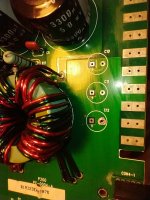 IMG_20220210_210213878_copy_768x1024.jpg201.4 KB · Views: 67
IMG_20220210_210213878_copy_768x1024.jpg201.4 KB · Views: 67 -
 IMG_20220204_105416556_copy_1024x768.jpg223.8 KB · Views: 64
IMG_20220204_105416556_copy_1024x768.jpg223.8 KB · Views: 64 -
 IMG_20220209_213734359_copy_768x1024.jpg161.7 KB · Views: 66
IMG_20220209_213734359_copy_768x1024.jpg161.7 KB · Views: 66 -
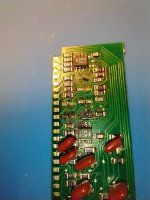 IMG_20220209_210225190_copy_768x1024.jpg195.8 KB · Views: 70
IMG_20220209_210225190_copy_768x1024.jpg195.8 KB · Views: 70 -
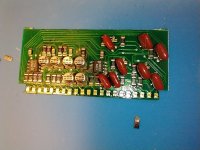 IMG_20220209_205908777_copy_1024x768.jpg203.2 KB · Views: 65
IMG_20220209_205908777_copy_1024x768.jpg203.2 KB · Views: 65 -
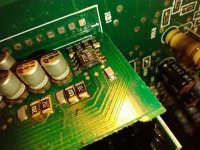 IMG_20220204_105430015_copy_1024x768.jpg215 KB · Views: 63
IMG_20220204_105430015_copy_1024x768.jpg215 KB · Views: 63 -
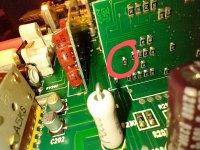 IMG_20220214_174126657~2_copy_1024x768.jpg228.8 KB · Views: 66
IMG_20220214_174126657~2_copy_1024x768.jpg228.8 KB · Views: 66 -
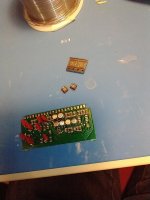 IMG_20220212_134230802_copy_768x1024.jpg167.6 KB · Views: 71
IMG_20220212_134230802_copy_768x1024.jpg167.6 KB · Views: 71
Thanks for posting what you had to do to get the amp repaired.
For those repairing these, ALL of the 10uF@16v SMD electrolytic caps in the amp must be replaced and the board must thoroughly be cleaned around them with acetone or a similar solvent. Any trace of electrolyte will be corrosive and conductive and could cause strange problems.
For those repairing these, ALL of the 10uF@16v SMD electrolytic caps in the amp must be replaced and the board must thoroughly be cleaned around them with acetone or a similar solvent. Any trace of electrolyte will be corrosive and conductive and could cause strange problems.
- Home
- General Interest
- Car Audio
- Rockford 200 DSM
